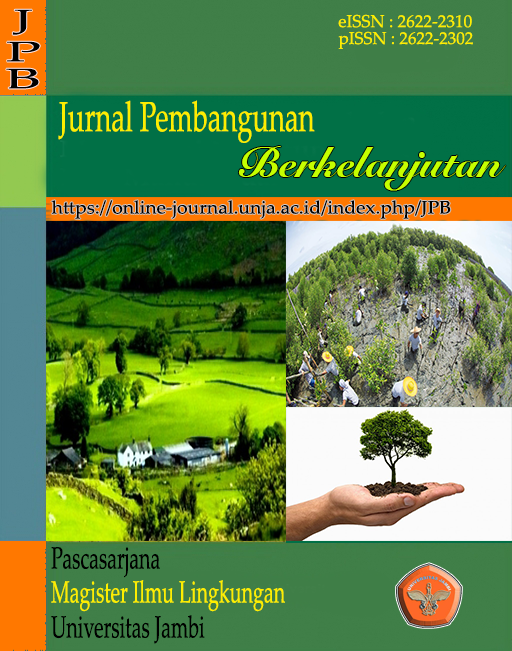Analisis Dampak Kemacetan Lalu Lintas Terhadap Pendapatan Masyarakat dan Aksesibilitas Di Kota Jambi
DOI:
https://doi.org/10.22437/jpb.v1i2.5398Keywords:
Keywords : crowded impact, society income, BBM and accessibilityAbstract
The research purposes are (1). To analyze the impact of crowded on society income. (2). To calculate the expenditure of BBM. And (3). To analyze accessibility of road users based on crowded. Research was done in Jambi Cityfrom February 2016 to March 2016. Three areas research were chosen based on crowded potential such as (a) area of Sungai Kambang, (b) area of Mayang Mengurai and (c) area of Jl Jalan Mayjen H M.J. Singedekane. From research result was got that some results as follows (a) crowded impact on society income in those area linked on timing of activity to end, founded loss time and loss productivity and from economics point of view cause loss of society income. (b) social economy impact on road users linked on the expenditure BBM causing loss of a lot of money comparing as usual. (c) based on accessibility point of view, got the result in middle and high categories that meant the rate accessibility road users was little bit low.
Downloads
References
Ayu, E. R . 2004. Willingnes To Pay Masyarakat Terhadap Perbaikan Ekosistem Hutan Mangrove Muara Angke Jakarta Utara Melalui Pendekatan Contingent Valuation Method (CVM) Dengan Analisis Regresi Logit. Skripsi. Program Studi Ekonomi Pertanian Dan Sumberdaya. Departemen Ilmu-Ilmu Sosial Ekonomi Pertanian. Fakultas Pertanian. Institut Pertanian Bogor, Bogor.
Black, 1981. Dynamics of Accessibility to Employment and Travel Behaviour: A Case Study of the Journey to Work in Sydney, Proceedings of International Symposium on Transport, Communication and Urban Form, Monash University. Part 2, pp.129-137.
BPS, 2015. Kota Jambi Dalam Angka, BPS Kota Jambi.
Khisty, J. C dan B. Kent L. 2003. Transportation Engineering : An Introduction, 3rd Edition. Pearson Education. Prentice Hall.
Manual Kapasitas Jalan Indonesia (MKJI), 1997, Direktorat Bina Jalan Kota, Direktorat Jendral Bina Marga Departemen PU, Sweroad, Jakarta.
Marito, V. H. 2006. Analisis Willingness To Accept Masyarakat Terhadap Tempat Pembuangan Akhir Sampah Bantargebang Dengan Pendekatan Contingent Valuation Method. Skripsi. Program Studi Ekonomi Pertanian Dan Sumberdaya. Departemen Ilmu-Ilmu Sosial Ekonomi Pertanian. Fakultas Pertanian. Institut Pertanian Bogor, Bogor
Munasinghe, M. 1993. Environmental and Sustainable Development World Bank Environment Paper Number 3 The World Bank. Washington DC USA.
Pangaribuan, G. P. 2005. Perhitungan Perbedaan Biaya Kemacetan Pada Sekitar Wilayah Pengendalian Lalu Lintas. Tesis. Program Pascasarjana Bidang Ilmu Teknik Program Studi Teknik Sipil. Fakultas Teknik. Universitas Indonesia, Jakarta.
Silalahi, A. D. 2001. Kajian Pendapatan Usaha Transportasi Angkutan Kota Bogor. Skripsi. Departemen Ilmu Ekonomi dan Studi Pembangunan. Fakultas Ekonomi dan Manajemen. Institut Pertanian Bogor, Bogor.
Soesilowati, E. 2008. Dampak Pertumbuhan Ekonomi Kota Semarang Terhadap Kemacetan Lalulintas Di Wilayah Pinggirian Dan Kebijakan Yang Ditempuhnya. Jurnal Ekonomi dan Kebijakan vol 1, pp 45-53 Universitas Negeri Semarang Semarang
Sugianto, G. 2011 Pengembangan Model Biaya Kemacetan Bagi Pengguna Mobil Pribadi Di Daerah Pusat Perkotaan Yogyakarta: Jurnal Transportasi Vol.11 pp 74-83.
Suparmoko, M. 2002. Penilaian Ekonomi: Sumberdaya Alam dan Lingkungan (Konsep dan Metode Penghitungan). LPPEM Wacana Mulia, Jakarta.
Tamin, O.Z. 2000.Perencanaan dan Permodelan Transportasi, Edisi kedua. Bandung: Penerbit ITB.
Tamin, O.Z dan Nahdalina. 1998. Analisis Dampak Lalu Lintas (Andall). Jurnal Perencanaan Wilayah dan Kota Vol 5 pp 16-25. ITB. Bandung.

Downloads
Published
Versions
- 2018-08-15 (1)
- 2018-08-15 (1)
How to Cite
Issue
Section
License
1. Authors retain copyright and grant the journal right of first publication with the work simultaneously licensed under a Creative Commons Attribution 4.0 International License that allows others to share the work with an acknowledgement of the work's authorship and initial publication in this journal.
2. Authors are able to enter into separate, additional contractual arrangements for the non-exclusive distribution of the journal's published version of the work (e.g., post it to an institutional repository or publish it in a book), with an acknowledgement of its initial publication in this journal.
3. Authors are permitted and encouraged to post their work online (e.g., in institutional repositories or on their website) prior to and during the submission process, as it can lead to productive exchanges, as well as earlier and greater citation of published work (The Effect of Open Access)










